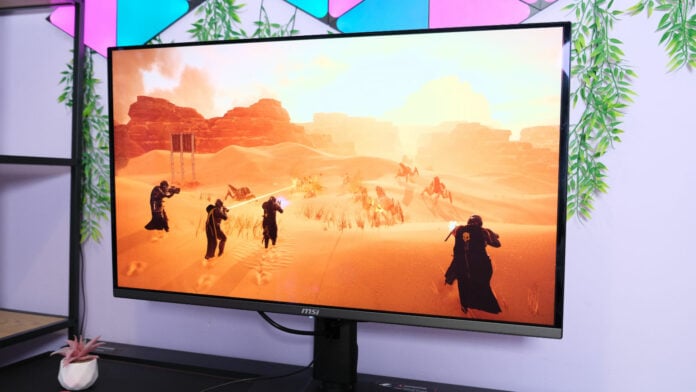MSI MPG 321URX QD-OLED heralds the final nail in the coffin of an age-old debate. Once upon a time, we’d argue which matters more: resolution or refresh rate. At 4K and 240Hz, you can have both uncompromised quality and performance, so long as you’re willing to pay for it.
Granted, it’s not the first gaming monitor with this combination. Samsung Odyssey Neo G8 debuted the duo way back in 2022, baked inside a Mini LED display. After that, though, it’s been slim pickings. Now the brand-new Samsung Display Gen 3 QD-OLED panel is out, the spec will soon be a lot more common.
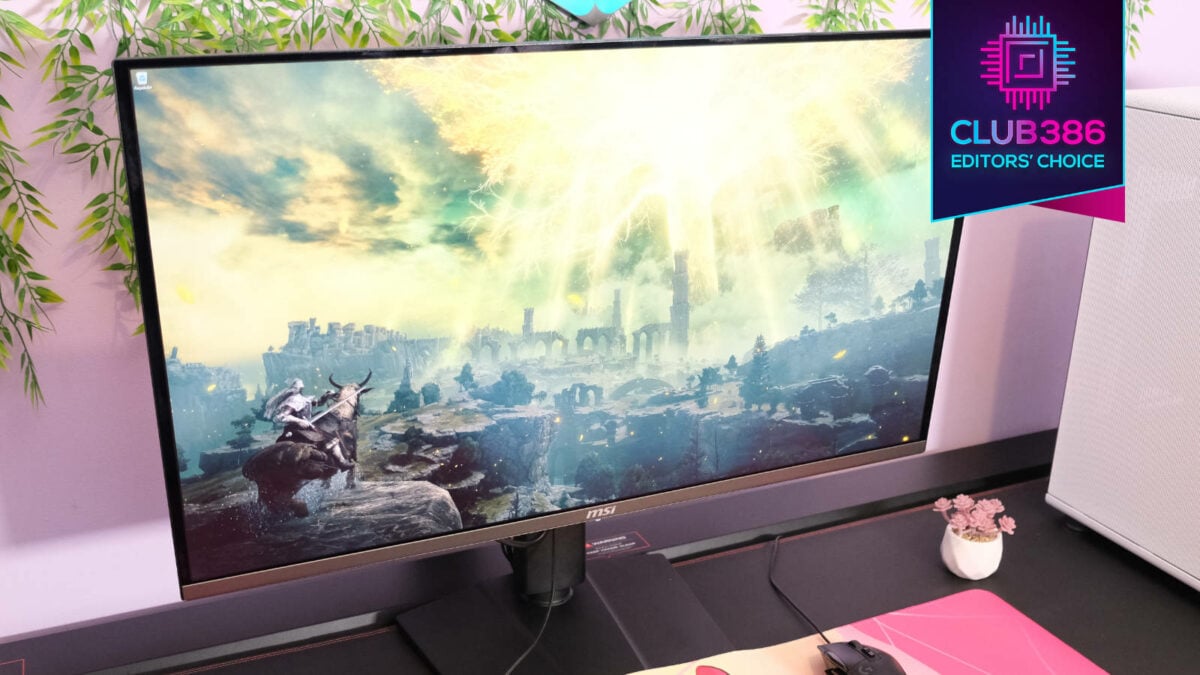
MSI MPG 321URX QD-OLED
£1299 / $950
Pros
- 4K/240Hz combo
- Colour accuracy
- Robust OLED Care
- Three-year warranty
- Great US price
Cons
- Cheap plastic stand
- Slightly lower gamut
- Fiddly VESA mount
- Fingerprint magnet
Club386 may earn an affiliate commission when you purchase products through links on our site.
How we test and review products.
MSI stands at the forefront with one of the first displays to adopt the third-gen 31.5in screen. Much like its predecessors, the Quantum Dot layer does a lot of heavy lifting. It offers richer colours, better brightness, and optimised viewing angles compared to OLEDs without one. Thankfully, there’s also no sign of variable refresh rate (VRR) flicker, which is the bane of my life on my personal monitor.
MPG 321URX arrived on digital shelves with a surprisingly low MSRP in the US, keeping it under four figures. Costing $950 / £1,299, it’s the cheapest you can get this tech, at least until the budget MSI MAG version crops up later this year. Cost parity across regions would be ideal, but let’s take the wins as they come. The cherry on top is a three-year warranty that even covers OLED burn-in.
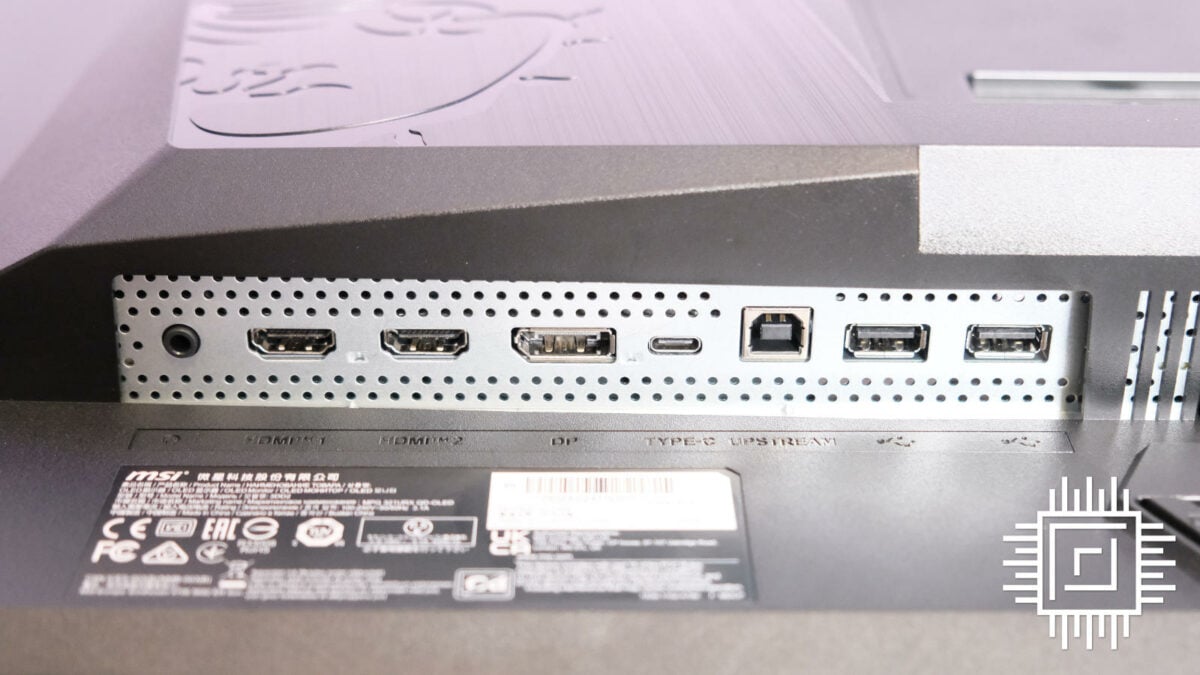
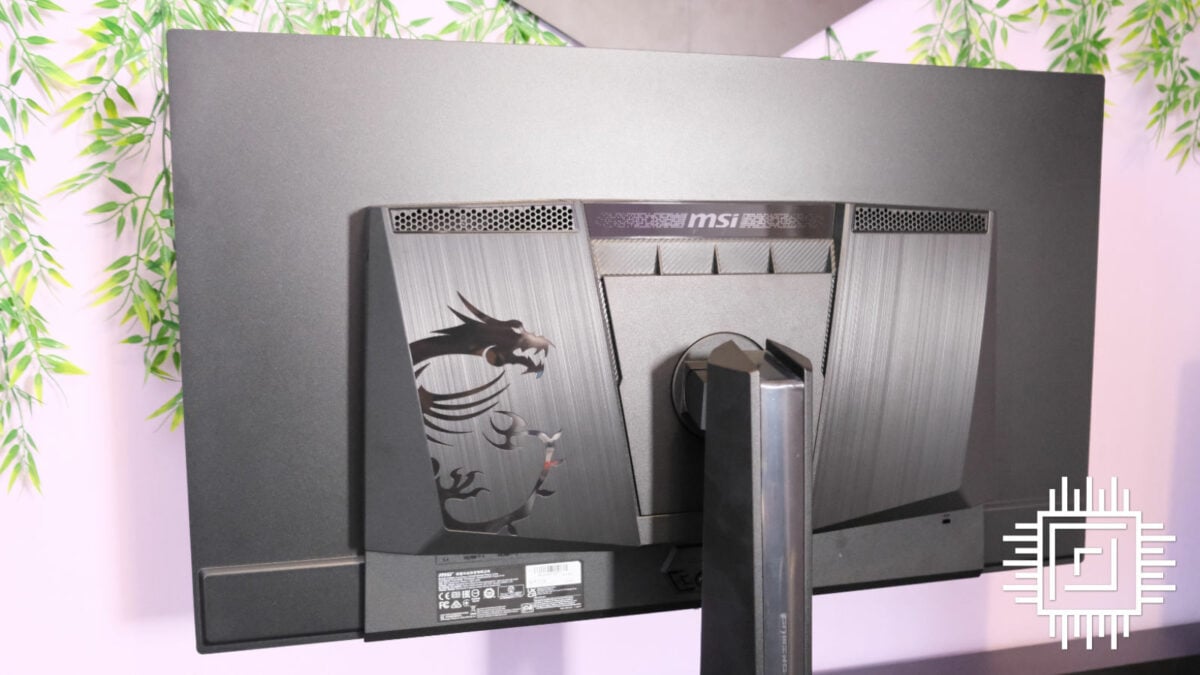
Ports and features
Achieving the full 240Hz refresh rate at 3480×2160 resolution will take the Herculean strength of the best graphics card in the latest games. MSI equips you with everything else you need. There’s a trusty DisplayPort 1.4a and two HDMI 2.1 ports on the rear. You can even attach a DisplayAlt cable via the Type-C port, which is otherwise capable of 90W power delivery.
KVM switches are more prevalent than ever, letting you plug your peripherals into the monitor. That said, they’re not a guarantee. Dell’s 32in Alienware rival doesn’t bother with the feature. MSI’s MPG 321URX thankfully does. There are two USB Type-A ports and a 3.5mm audio jack that feed into your PC via either the Type-C or Type-B cable. Both are provided in the box. Dual ports are enough for most, as they cater to your mouse and keyboard. I, on the other hand, miss Corsair Xeneon’s comprehensive four-port offering.
Downward-facing ports often leave a bad taste in my mouth because they risk leaving your cables looking messy underneath. MSI handles this well, with a deep lip that covers all except the thickest wires. The stand’s cable grommet also does a good job of feeding them through to the rear, to the point even the 110mm height adjustment doesn’t reveal anything at its highest peak. However, the base of the stand could use a trench to run peripheral cables to the back. As it stands, the only way to plug them into the KVM is a bit messy.
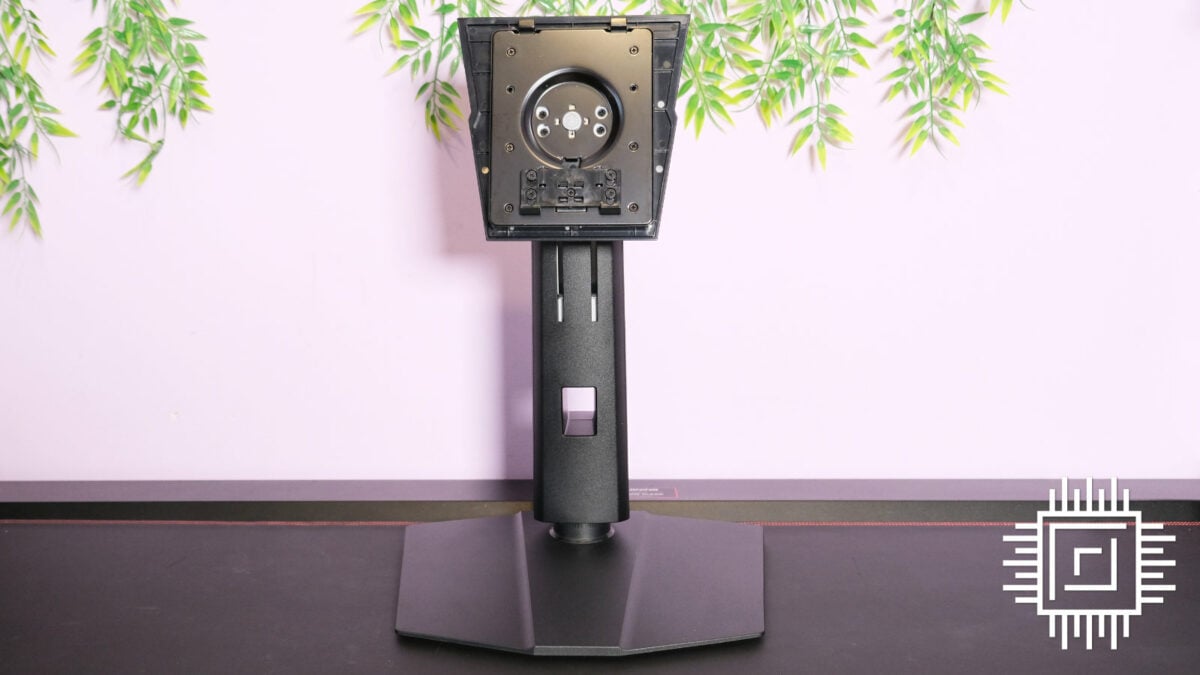

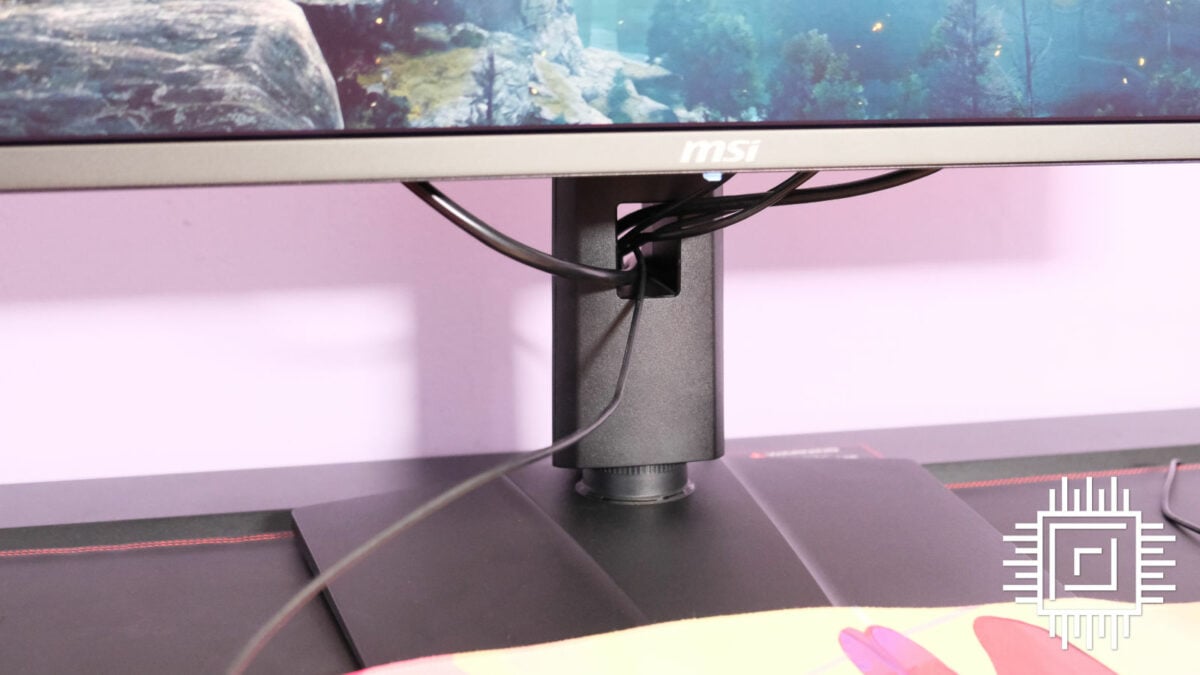
Speaking of the stand, the plastic approach feels a little cheap. Given how much it undercuts the competition price-wise, the quality dip is a worthy sacrifice. At the very least, it does its job well. Clipping the display on is completely tool-less, and you have ample room to point it where you like. It tilts between -5° and 15°, swivels through -30° and 30°, and pivots 10° either way.
If, like me, you’d prefer to pop it on your wall or clamp it to your desk, the monitor has 100×100 VESA support. It’s awkwardly placed deep inside a concave, though. That might not seem like a big deal, but quick-release attachments like Secretlab’s slide-on mount simply won’t work as intended. Instead, you’ll need to screw it in directly, which is a pain.
Unlike the stand, the rest of the monitor feels well-built with high-quality materials and next to no bezels. It follows the trend of thin, 4mm flat screens with a bulky rear to house the ports and dedicated cooling. You see, OLED has no chill and needs to be kept in check. Fortunately, being part of the new generation, the monitor benefits from a fan-less custom heatsink and graphene film to aid heat dissipation.
Furthermore, there’s even a touch of RGB on the MSI logo that you can customise using the on-screen display (OSD). It’s largely useless, confined to the backside, and not bright enough to glow on the wall behind. Still, it looks nice when you’re setting it up.
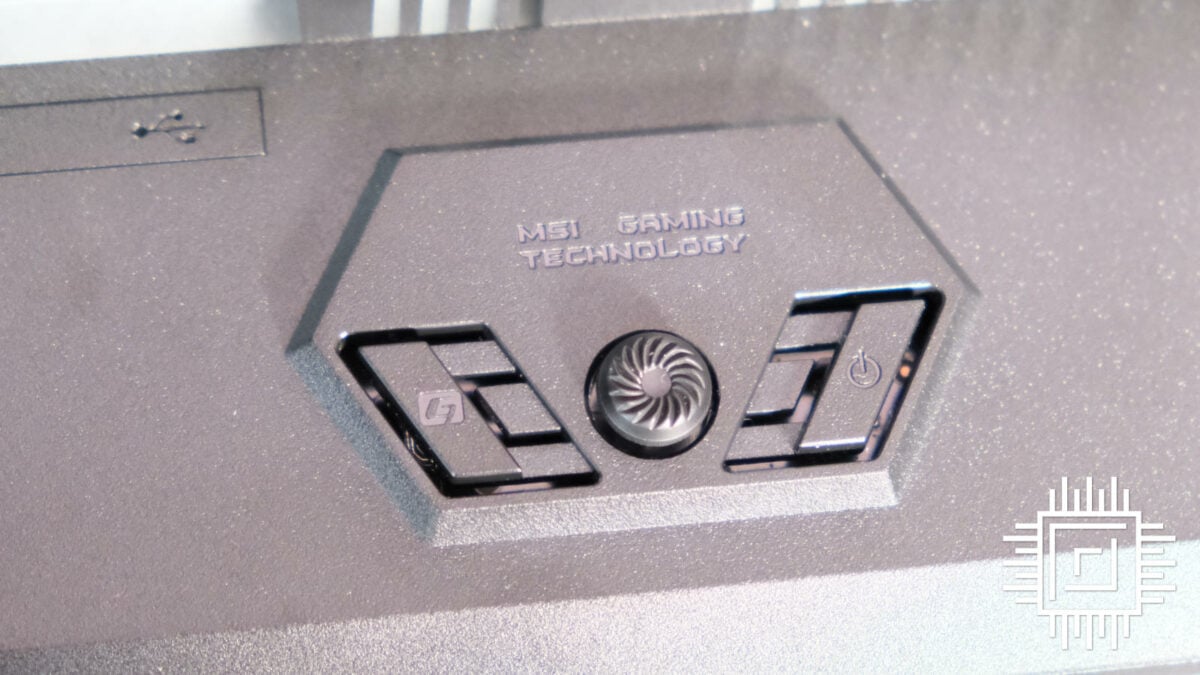
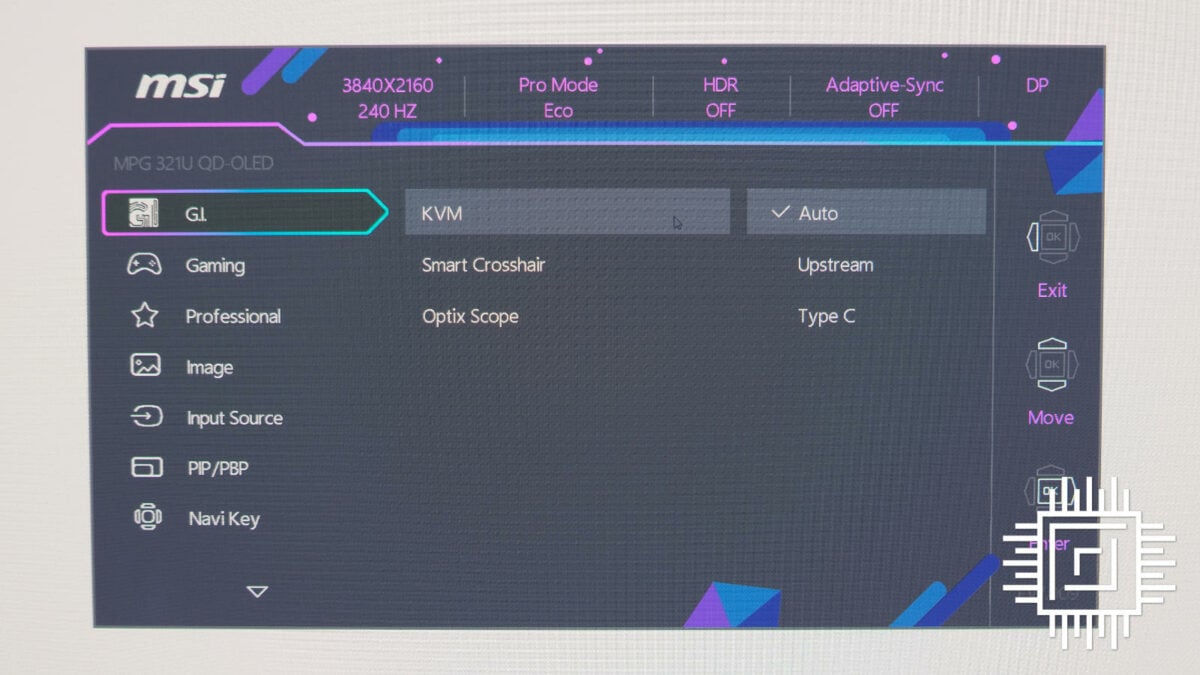
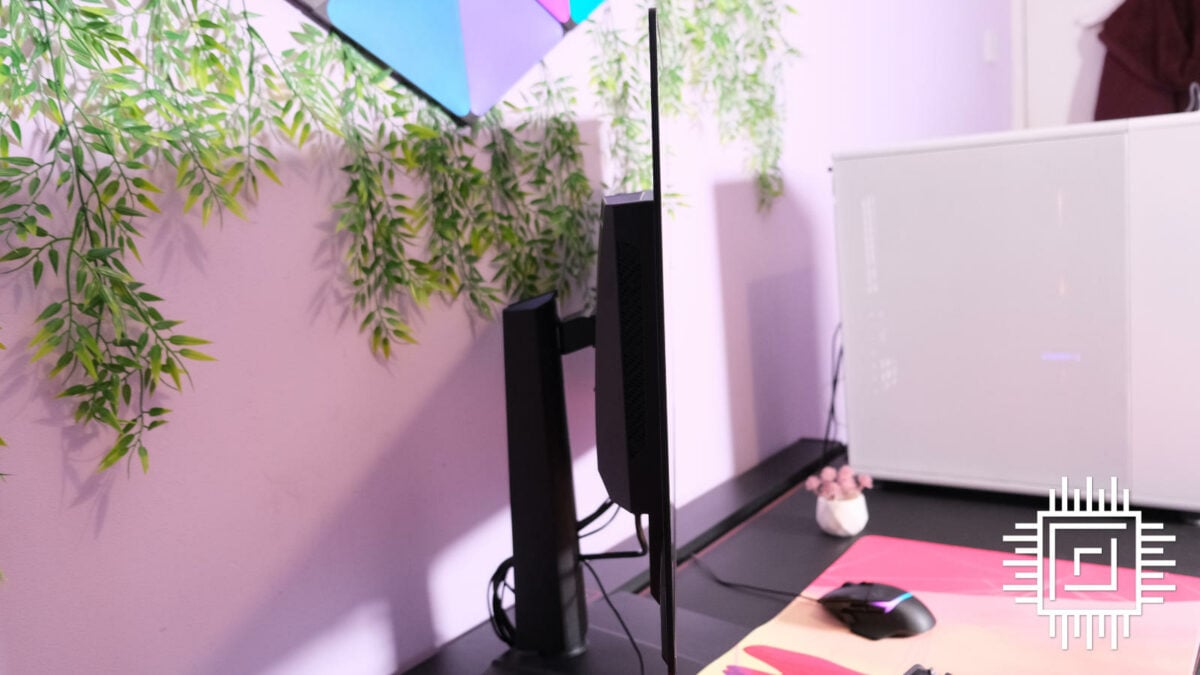

The rest of the OSD is completely painless to navigate using the five-way joystick. You can set the four-way navigation as shortcuts to your most-visited options or press it in for the complete menu. I never really bother with crosshairs, but there are plenty to select if that’s your bag. There’s even an AI Vision option that acts like the Black Equaliser on the Gigabyte Aorus CO49DQ, boosting the brightness of certain elements without impacting deep blacks. It’s particularly handy for spotting enemies in an FPS game.
Since this is a QD-OLED panel, MSI packs its comprehensive OLED Care 2.0 suite to keep you safe from burn-in. After all, no one wants a ghostly image lingering long after you’ve switched the thing off. Between Pixel Shift, Panel Protect, and several detection modes that target static screens, logos, and taskbars, it’s well-equipped to stave off the issue. Just keep in mind that most of these are off by default. I haven’t had the monitor long enough to conduct a burn-in test myself. Preventative measures are always better than curing it, however, and MSI has them in spades.
Lightspeed gaming
UHD with a 240Hz refresh rate on top of a QD-OLED panel is my dream scenario. I understand that the idea of an endgame monitor to rule all displays is a fallacy since technology is always evolving, but it’s so future-proofed that it’s hard to imagine when the next upgrade will come along. You’ll already have a tough time using all it has to offer.
Performance depends on your PC hardware. Even top-tier Nvidia GeForce RTX 40-class cards can only pull the magic of 4K at 240fps in select games. You can probably squeeze enough frames out of Titanfall 2, some of the older F1 games, and competitive options like Counter-Strike, but you’ll more likely find yourself adjusting the resolution in favour of performance. Upscalers like AMD FSR, Nvidia DLSS, and Intel XeSS are fast improving, though, so it won’t be long before these specs become a lot more viable.
Pairing with its lovely visuals is an industry-leading 0.03ms response time for swift grey-to-grey (GtG). You won’t likely see the difference between this and the upper 3ms average unless you’re superhuman. Still, we take every advantage we can get, and these features usually have a knock-on effect, aiding lower latency.
The absence of AMD FreeSync or Nvidia G-Sync compatibility is a curious one that’s carried over from MSI MEG 342C QD-OLED. It’s not without variable refresh rate (VRR) support preventing screen tearing; it’s just not branded. The feature is well implemented, though, as I didn’t notice a single stumble when playing Rainbow Six Siege. PlayStation 5 and Xbox Series users can also benefit from Console VRR by running through an HDMI port, and it’ll scale down from 4K to 1440p.
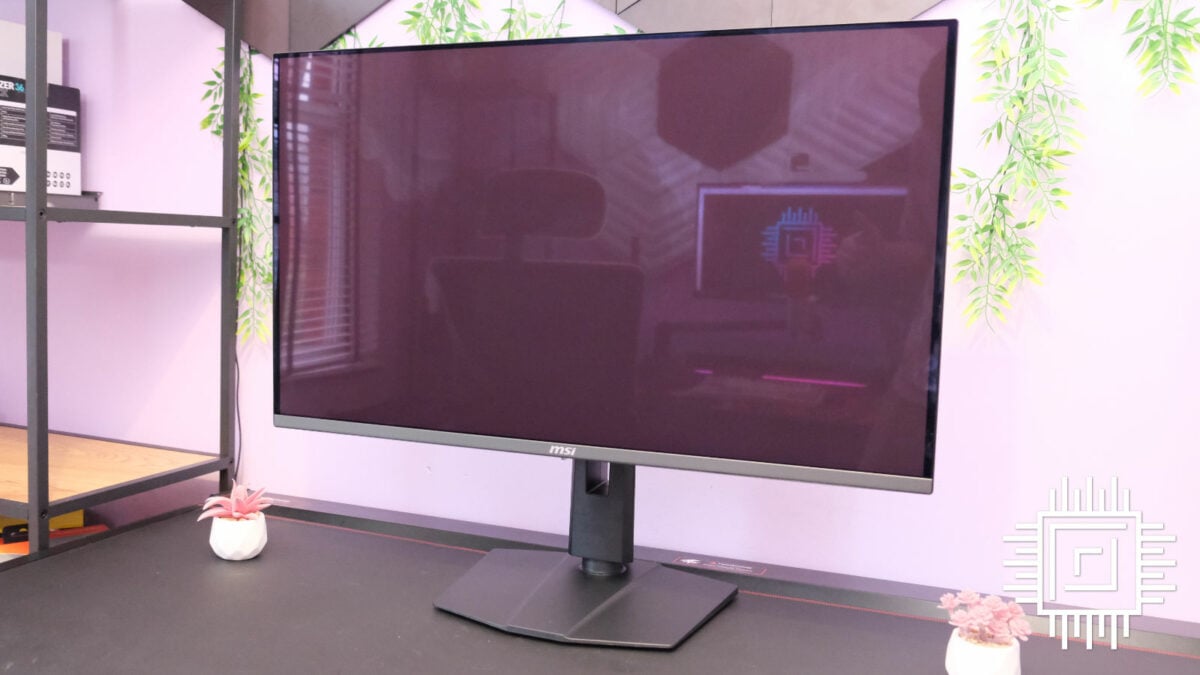
Ever since I tried Dough’s (formerly Eve’s) Spectrum Black, I’ve been a big fan of glossy screens. MSI’s monitor uses Samsung’s signature coating, which brings the deeper blacks and bolder colours of a shiny screen but runs an anti-reflective treatment to stop you from seeing your own mug staring back. Reflections are as clear as day when everything’s off, as you can see above. You won’t have that problem when it’s on.
Just make sure there aren’t any bright light sources positioned in front of the monitor, otherwise they might glare. It’s a particular pain if you run RGB lights on your back wall, like Nanoleaf Shapes, or have a window behind you. Still, it’s a minor concern with a worthy trade-off.
Performance
Colour credentials
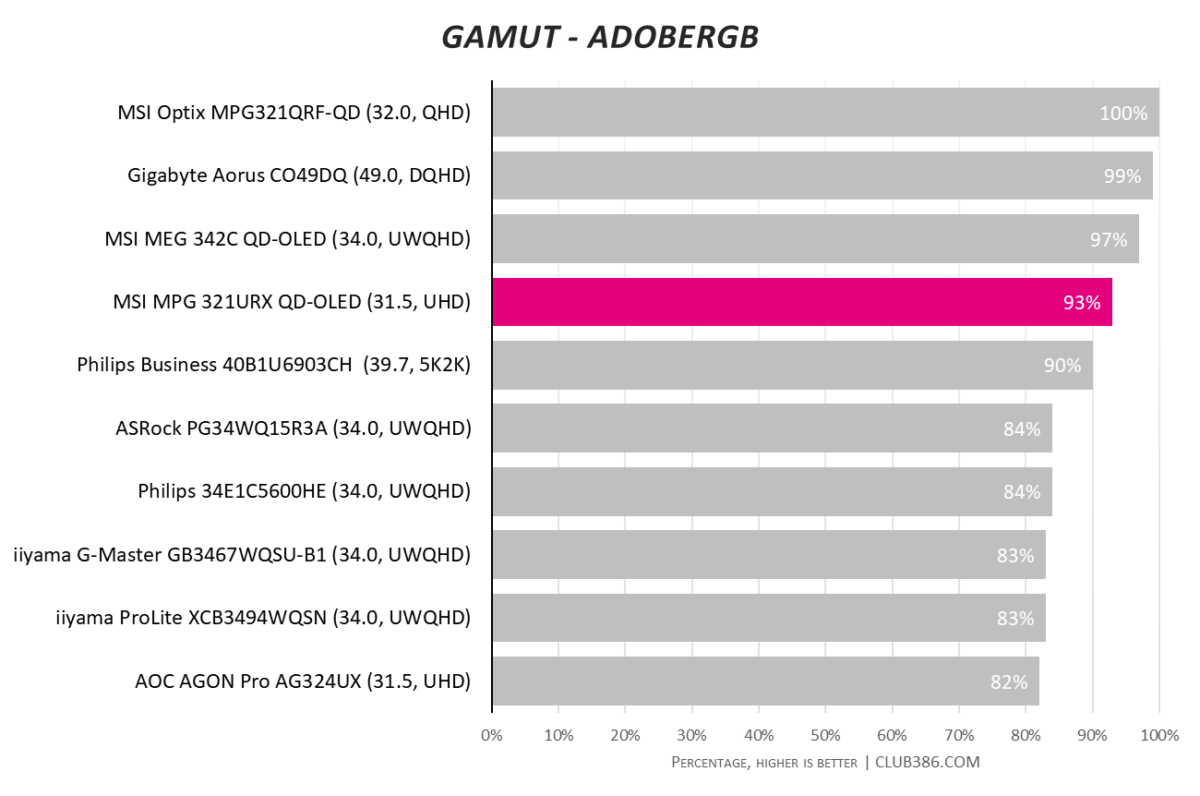
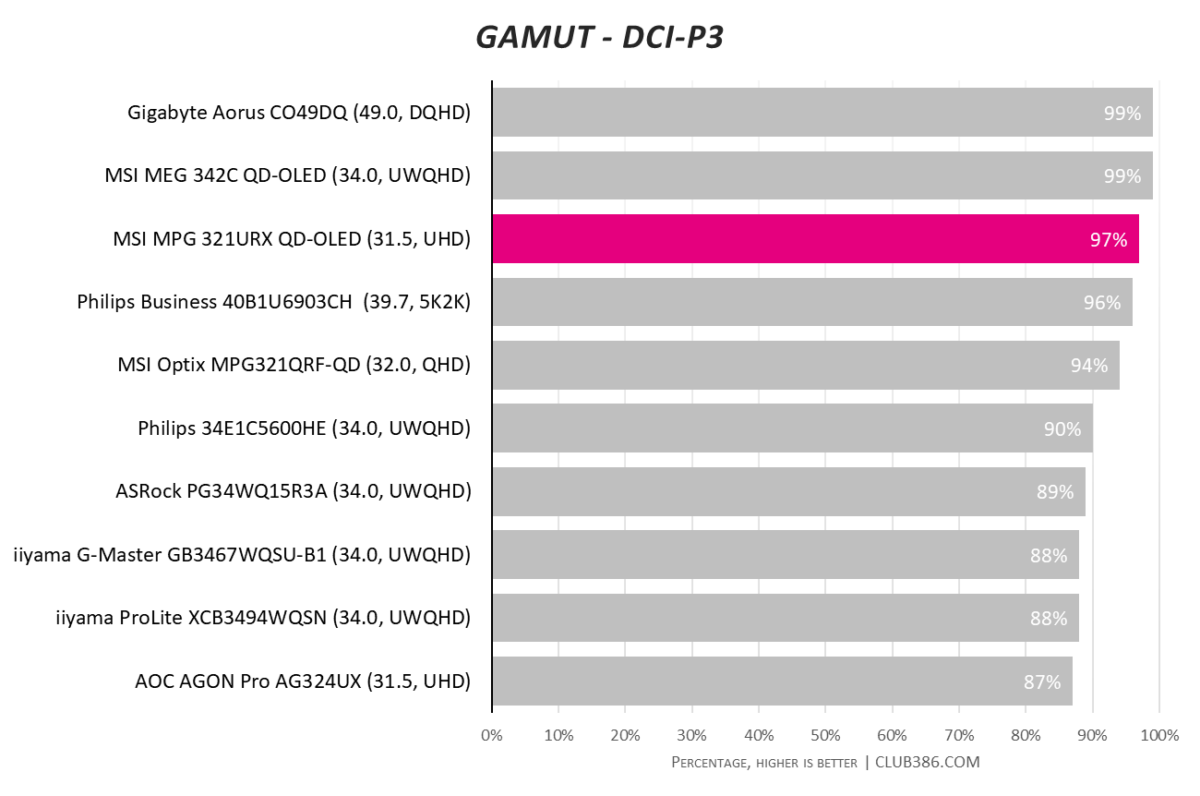
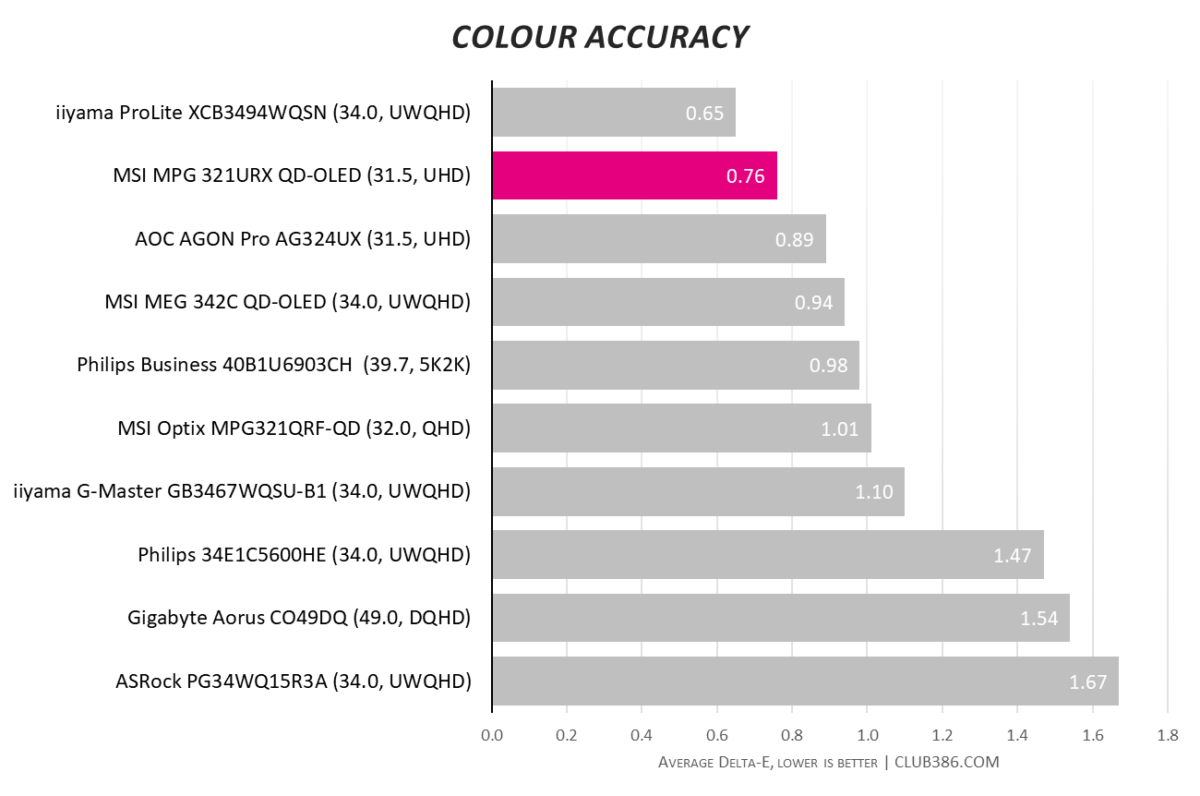
MSI says the monitor hits 97% AdobeRGB and 99% DCI-P3, but the default Eco profile falls short at 93% and 97%, respectively. Switching to the dedicated AdobeRGB mode doesn’t remedy this as you might hope. In fact, it makes things worse by lowering DCI-P3 to the same level.
Gamut woes aside, none of this harms the user experience. MSI MPG 321URX actually touts one of the best colour accuracies we’ve seen. We consider anything less than a 1.0 Delta-E as ideal, and the display keeps good company surrounded by professional offerings from iiyama and Philips.
Brightness and contrast
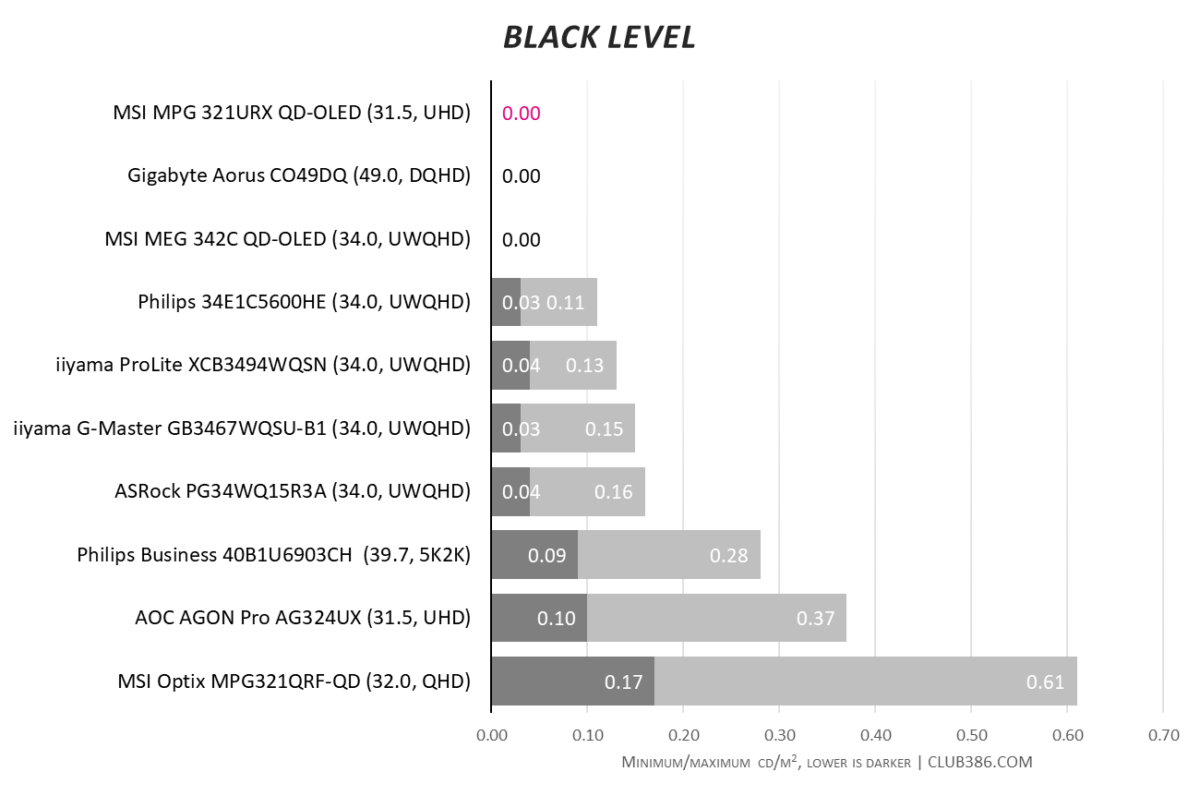
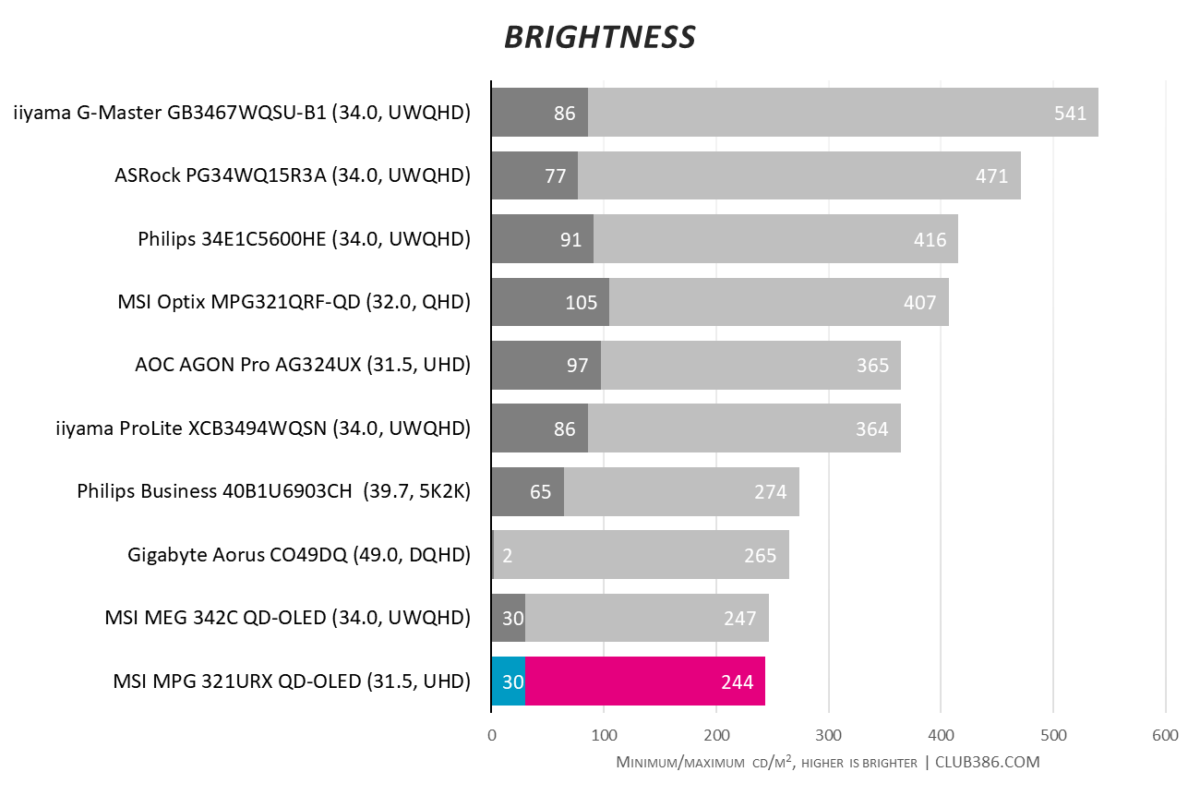
QD-OLED’s biggest strength comes from its independent pixels. Rather than relying on a backlight, each can switch off independently, giving perfect blacks and a near-infinite contrast ratio. You can’t get any better, but it’s a feature all types of OLED share. This also lends itself to fantastic high-dynamic range coverage, avoiding backlight zones and potential bleeding. You can seamlessly switch between DisplayHDR True Black 400 or push it to a Peak 1,000nits mode that makes use of the full brightness. Bigger is almost always better here, making the latter the obvious choice for HDR content.
Brightness, on the other hand, is OLED’s biggest weakness for the exact same reason. Without the help of a backlight, screens are dimmer than IPS, VA, and TN alternatives. The Quantum Dot layer adds a helping hand compared to displays without the tech, although it’s still on the low side. While Samsung’s Display Gen 3 panel is supposed to yield higher peak brightness than its predecessor, MPG 321URX is the darkest screen to pass through our lab. It’s 244cd/m² could be higher, but it’s actually on target for MSI’s claimed 250cd/m².
This seems to be a recurring thing for the brand, as it’s a stone’s throw from MSI MEG 342C. Much like its ultrawide brethren, it’s not as much of an issue as you might expect. There’s a chance you might notice a difference in a particularly bright room, but I didn’t have any issues during my time with the display.
Uniformity and efficiency
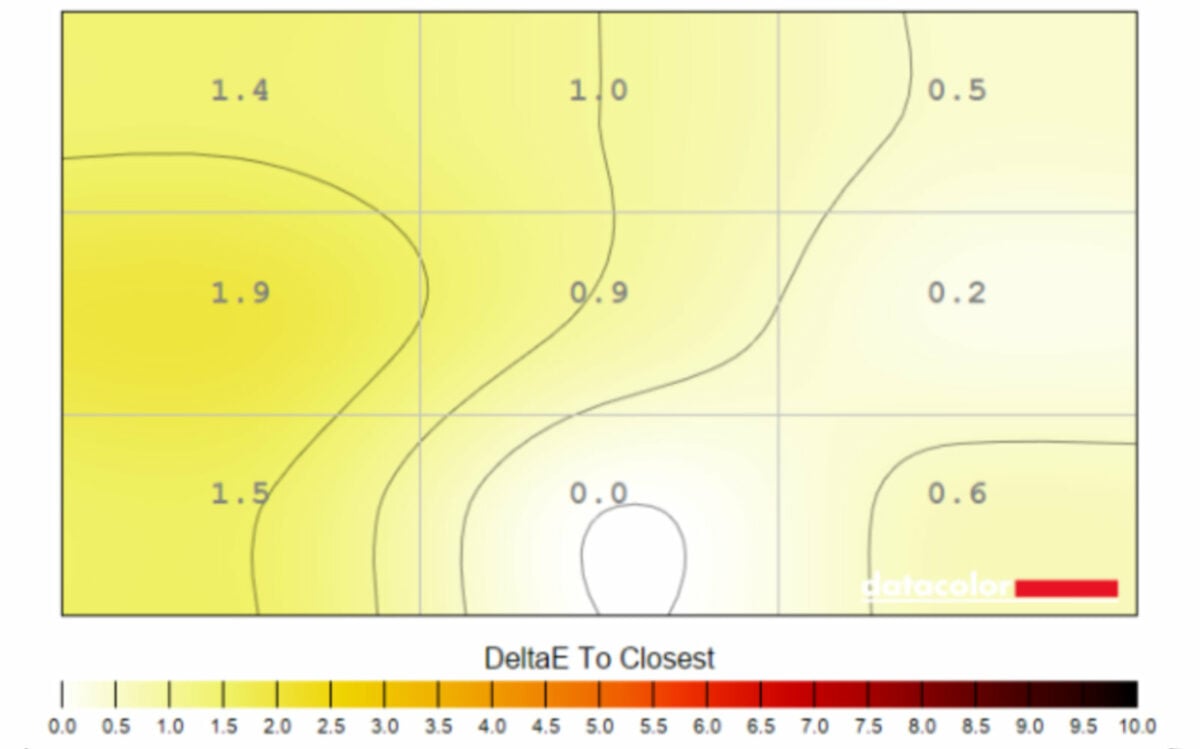
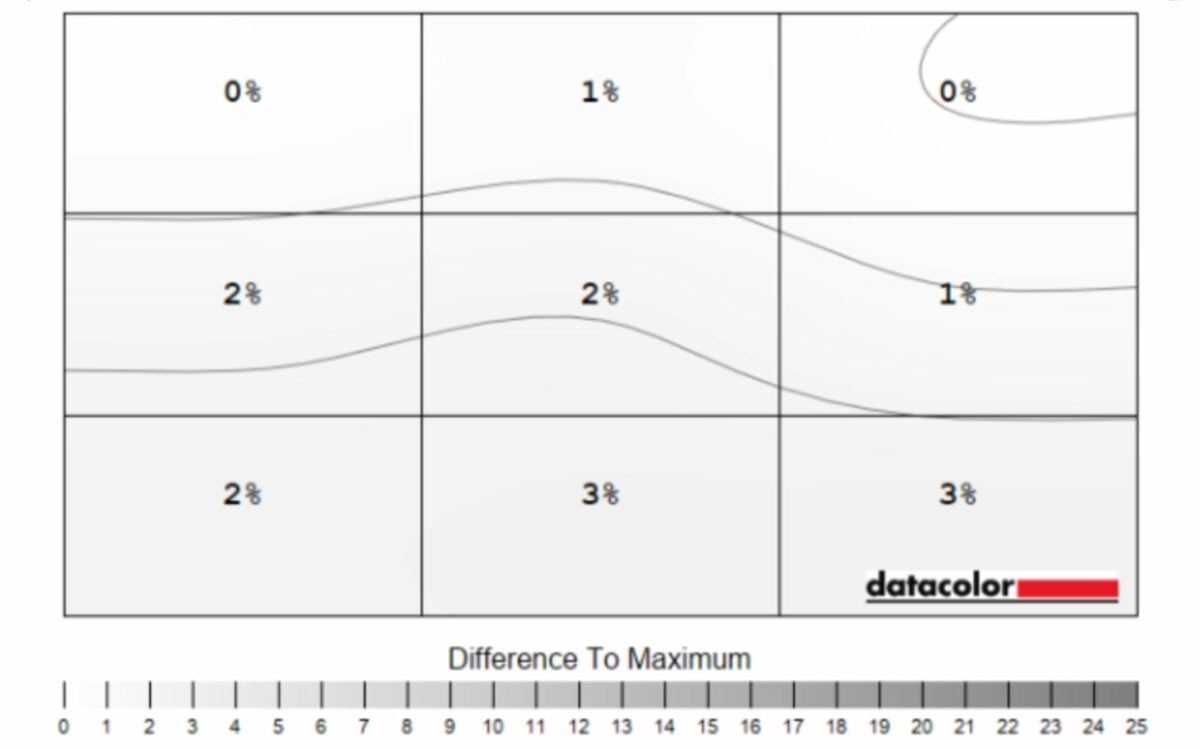
Anything under 10% uniformity is ideal. Sitting under 3% is downright fantastic. Corner to corner, MPG 321URX doesn’t waiver in brightness or colour. To the naked eye, you won’t spot anything amiss.
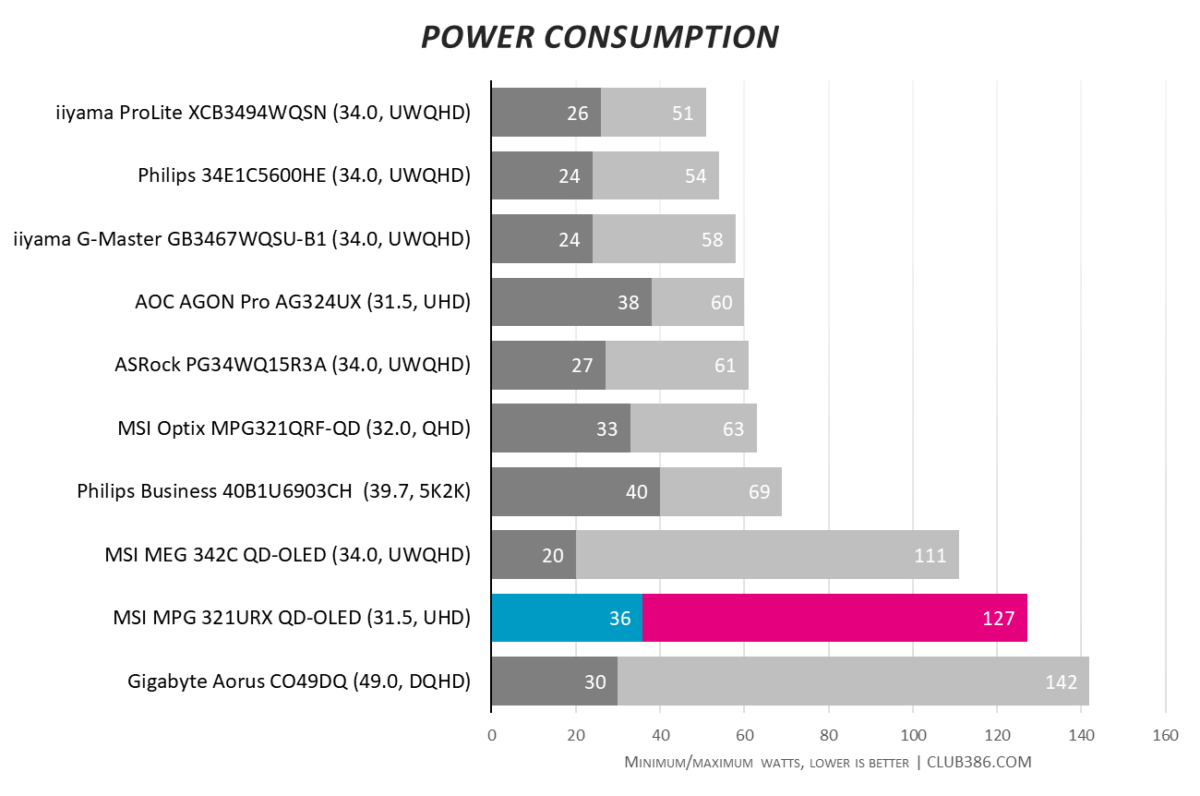
OLED is a bit of a guzzler at the best of times, but pairing it with 4K resolution makes it a hungry beast. The only display to out-gobble it is a whopping 49in. It’s a fair deal for the performance it offers. You can take solace in that it’ll rarely reach 127W unless you’re running a pure white screen. Self-lighting pixels are an energy bill’s best friend, keeping the average much lower.
Conclusion
Any OLED could take the top spot in 2024, as they all share the same panels from Samsung or LG and are dazzling from the moment you switch them on. MSI MPG 321URX QD-OLED sets itself apart with a superb feature set. From top to bottom, it has impeccable custom colour calibration, a KVM switch, a robust suite of burn-in prevention measures, and a rock-bottom price tag.
It’s not quite a perfect showing, mind you. The plastic stand leaves something to be desired with quality, the VESA mount is unnecessarily fiddly, and the glossy coating brings the risk of reflections from brighter sources. Still, this all feels comparatively nitpicky to an otherwise stellar gaming monitor.
UHD at 240Hz is a bold move I’d usually only recommend if you plan on future proofing. Those with the budget can’t afford to look anywhere other than MSI MPG 321URX QD-OLED, though, as it undercuts the competition by more than 20% in the US. I wish the $950 price tag carried overseas as £1,299 is a tougher swallow, but there’s enough here to warrant it.
Verdict: an uncompromising QD-OLED gaming monitor that proves UHD and 240Hz are a match made in heaven.

